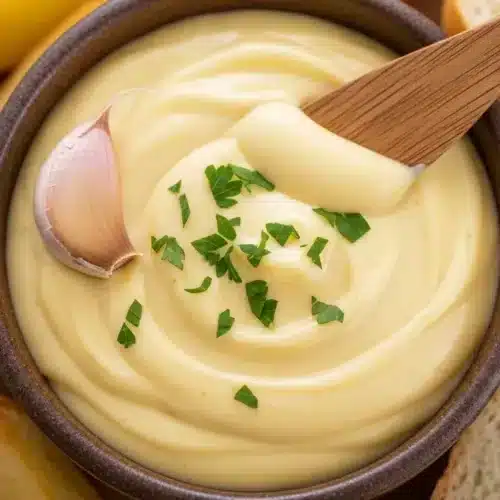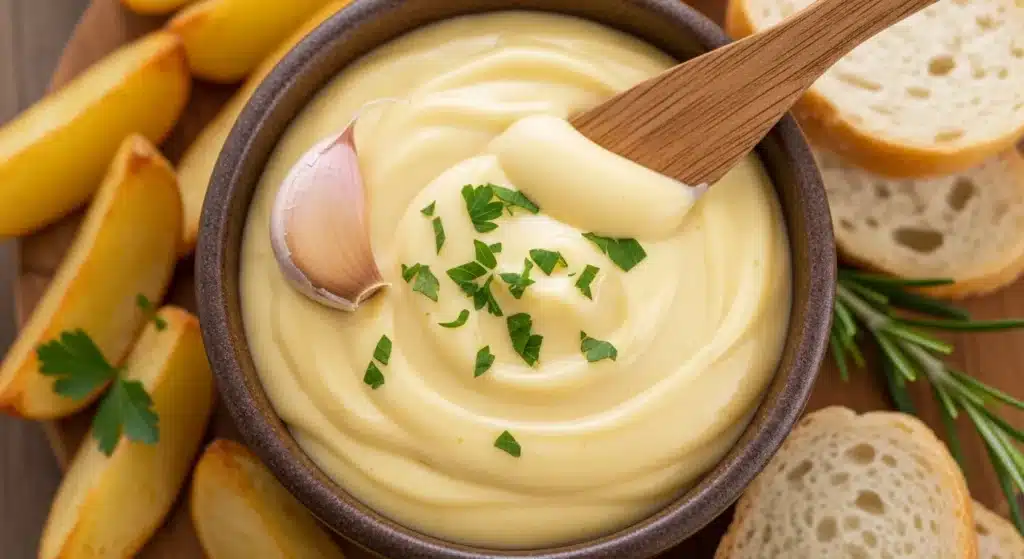You know that moment when you dip a fry into something so ridiculously creamy and garlicky, you pause mid-bite and whisper, “What IS this magic?” Yeah. That’s aioli.
Aioli is the MVP of condiments—the silky, rich, flavor-packed spread that makes everything better. Sandwich feeling bland? Slather on some aioli. Veggies looking sad? Dip away. Hosting a get-together? A bowl of homemade aioli screams “I have my life together,” even if you made it while still wearing pajama pants. (No judgment—I do that, too.)
In this article, we’re going to talk about all things creamy, garlicky aioli—from what it is (spoiler: it’s more than just fancy mayo) to how to make it, use it, and even zhuzh it up a little when you’re feeling extra. Let’s get into it. 😎
What Even Is Aioli?
Okay, let’s clear something up real quick. Is aioli just garlic mayo? Well… yes and no.
The OG Aioli
Traditional aioli (we’re talking old-school Mediterranean style) is made with:
- Garlic
- Olive oil
- Salt
- That’s it. No eggs. No lemon. No whisking in a blender.
Instead, it’s pounded into submission with a mortar and pestle until it emulsifies into a thick, almost paste-like sauce. Tbh, it’s a whole workout—but worth it if you’re feeling chef-y.
The Modern Aioli
Now, the version most of us know and love (and can actually whip up in under 5 minutes) is a bit different. It includes:
- Garlic (duh)
- Egg yolk
- Lemon juice
- Dijon mustard (sometimes)
- Oil (olive or neutral)
And voila—a creamy, garlicky spread that tastes amazing and looks super fancy, even though it’s deceptively simple.
Why You’ll Want to Put Aioli on Literally Everything
Let me put it this way: if ketchup is the prom king of condiments, aioli is the mysterious exchange student everyone secretly wants to hang out with. Here’s why:
- Creamy Texture: Like, lick-the-spoon creamy.
- Bold Garlic Flavor: Not shy. Not subtle. Just glorious, garlicky punch.
- Versatility: It works with everything—fries, sandwiches, grilled veggies, seafood… name it.
- Customizable AF: Add herbs, lemon zest, roasted peppers, chipotle… you get the idea.
TL;DR: Once you make aioli, you’ll find excuses to use it. I dipped leftover meatballs in it the other day. Zero regrets.
How to Make Creamy, Garlicky Aioli (Without Losing Your Mind)
This is the part where people panic and go, “But emulsions are hard!” Chill. It’s easier than you think—and I’ll walk you through it like a good foodie friend would.
Ingredients You’ll Need
- 2 egg yolks (room temp—trust me, it matters)
- 1 tablespoon lemon juice
- 1 teaspoon Dijon mustard
- 2–3 garlic cloves (grated or minced)
- 1 cup neutral oil (canola, sunflower, or light olive oil)
- Salt to taste
Optional But Delicious Add-Ins
- A dash of paprika
- A pinch of cayenne
- Finely chopped fresh herbs
- Zest of a lemon or lime
Directions
- Whisk it like you mean it: In a bowl, combine the yolks, lemon juice, mustard, and garlic.
- Add oil slooooowly: Start with a few drops at a time while whisking constantly. Once it starts to thicken, you can go a bit faster—think a slow, steady drizzle.
- Keep whisking: Don’t stop until it’s thick and luscious.
- Season to taste: Add salt, extra garlic, lemon juice, whatever your garlicky little heart desires.
FYI: If it breaks (aka turns into a runny mess), don’t freak. Whisk a fresh yolk in a clean bowl and slowly add your broken mixture back in. Problem solved.
Shortcut: Blender or Food Processor Method
Ain’t nobody got time for elbow cramps? I feel you.
Throw everything (except the oil) into a food processor or blender. Blitz it, then drizzle in the oil while blending. Same dreamy results, less wrist pain. 🙂
The Best Ways to Use Aioli (a.k.a. Where Not to Use It Would Be a Shorter List)
Okay, so you’ve made this creamy masterpiece. Now what?
Dip It
- French fries
- Sweet potato wedges
- Fried pickles (don’t knock it ‘til you try it)
- Shrimp or calamari
Spread It
- Grilled chicken sandwiches
- Turkey paninis
- Veggie wraps
- Breakfast burritos (yes, it works—trust me)
Top It
- Grilled steak or chicken
- Roasted veggies
- Poached eggs
- Fish tacos (ohhhh yes)
Basically, if you can eat it, you can probably aioli it.
Aioli Variations That’ll Blow Your Mind (In a Good Way)
Feeling fancy? Or bored? Either way, these twists on the classic will keep things interesting:
Chipotle Aioli
Smoky, spicy, and perfect on tacos. Just blend in a chipotle pepper (from a can of adobo) or a dash of smoked paprika.
Basil Aioli
Blitz in some fresh basil for a green, herbaceous twist that pairs beautifully with roasted veggies or caprese sandwiches.
Parmesan Garlic Aioli
Add finely grated parmesan for a cheesy umami bomb. It’s chef’s kiss with burgers or fries.
Mango-Lime Aioli
Yes, it sounds weird. But trust—this sweet-and-savory combo slaps, especially with grilled seafood.
IMO, aioli is like pizza—even when it’s different, it’s still delicious.
Common Aioli Mistakes (And How Not to Make Them)
Because we’ve all been there… staring at a bowl of garlic-scented oil soup wondering what went wrong.
You added oil too fast
Solution: Patience, young grasshopper. Slow drizzle = smooth emulsion.
Your ingredients were too cold
Solution: Room temp everything. Cold eggs = broken dreams.
You didn’t whisk enough
Solution: Channel your inner whisk ninja. Commit.
You used extra virgin olive oil
Okay, hear me out—EVOO has a strong flavor, which can overpower everything else. Go with something more neutral for the base, then finish with a splash of EVOO if you’re craving that punchy olive taste.
Is Aioli Healthy?
Ah, the eternal question. Here’s the deal:
- It’s made from real ingredients—eggs, oil, garlic, lemon.
- No preservatives, no weird stuff you can’t pronounce.
- High in healthy fats, especially if you use good-quality oils.
But yeah, it’s still rich. So maybe don’t eat it by the spoonful. (Unless you’re having a rough day. Then go for it. I won’t tell.)
Can You Store It?
You bet.
Fridge Life:
- Keep it in an airtight container.
- Good for up to 4 days.
- Always smell it before using. If it smells funky, toss it. No one wants sketchy aioli.
FAQs About Creamy, Garlicky Aioli
Q: Can I make aioli without raw eggs?
A: Yup! Use pasteurized eggs or go for an eggless version using aquafaba (the liquid from canned chickpeas). Works like a charm.
Q: What’s the best oil for aioli?
A: Use a neutral oil like canola or sunflower for a mild base. Add a splash of EVOO at the end if you want a stronger flavor.
Q: How garlicky is too garlicky?
A: That’s like asking how tall is too tall for a stack of pancakes. IMO, more garlic = better. But if you’re garlic-sensitive, start with one clove and work your way up.
Q: Can I freeze aioli?
A: Nope. The texture gets weird and splits. Just make fresh batches and enjoy within a few days.
Want more kitchen wins like this? Bookmark this page, grab your whisk, and join the creamy revolution. Your fries will thank you. 💯
Related Recipes:
- Herbed Garlic Bread:
- KFC Coleslaw Recipe: Easy, Creamy, Crunchy Side Dish
- 30-Minute Garlic Parmesan Dinner Rolls: Easy, Cheesy Recipe
Final Thoughts:
Look, if you’re still wondering whether it’s worth the trouble—it absolutely is.
Homemade aioli beats store-bought every single time, and once you get the hang of it, you’ll whip it up in your sleep (well, not literally… please don’t try that).
It’s one of those simple pleasures that makes any meal feel special. So whether you’re dipping fries, layering it on a burger, or just eating it with a spoon while pretending to “taste test”… you’ve got a winner.
And hey—next time someone asks what your secret sauce is, you can just wink and say, “It’s aioli, baby.” 😉

Creamy, Garlicky Aioli Perfect for Dipping and Spreading
Ingredients
- 6 tablespoons mayonnaise
- 2 cloves garlic minced or grated
- 2 tablespoons olive oil
- 1 teaspoon fresh lemon juice
- ¼ teaspoon coarse ground black pepper
- Optional: pinch of salt to taste
Instructions
- In a small bowl, whisk together mayonnaise and minced garlic.
- Slowly drizzle in olive oil while whisking to combine.
- Add lemon juice and pepper, then whisk until creamy and smooth.
- Adjust salt if needed.
- Cover and refrigerate for at least 30 minutes before serving to let flavors meld.
Notes
- Use a microplane grater for the garlic to ensure even distribution.
- For a whipped texture, use an immersion blender.
- Substitute avocado oil for olive oil for a milder flavor.
- Do not freeze; best fresh and refrigerated up to 3-5 days.
- Perfect spread for sandwiches or dip for fries and veggies.
DID YOU MAKE THIS EASY RECIPE?
If you have, then share it with us by sending a photo. We’re excited to see what you’ve made:
Printable Recipe Card
Want just the essential recipe details without scrolling through the article? Get our printable recipe card with just the ingredients and instructions.



